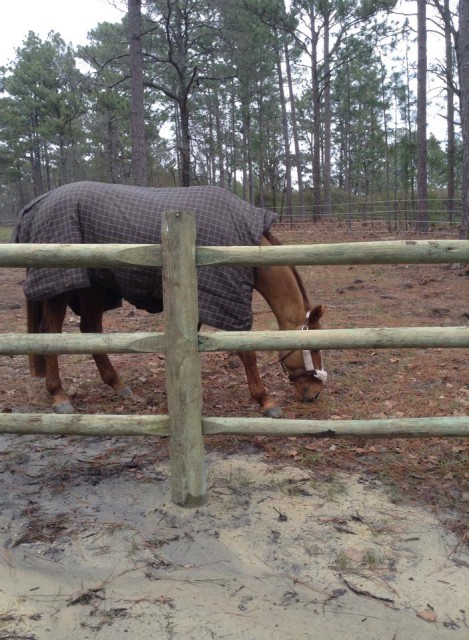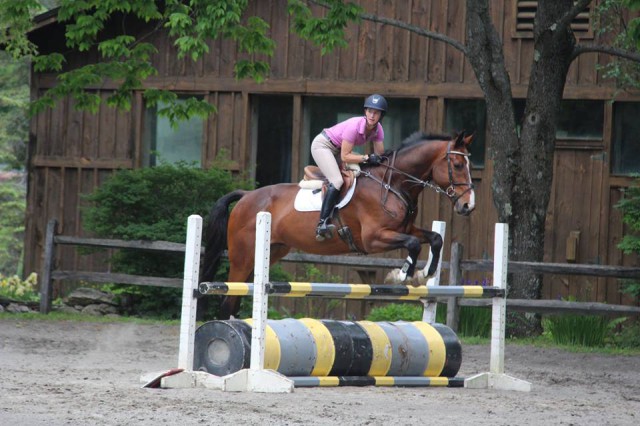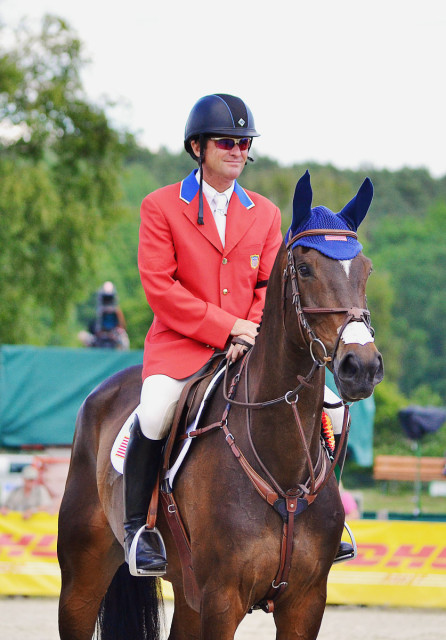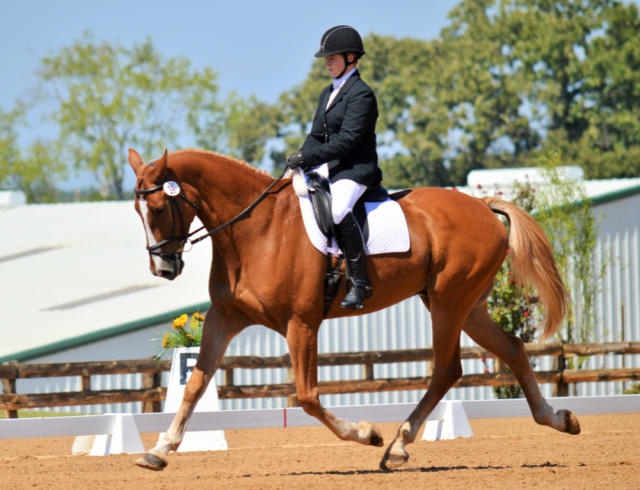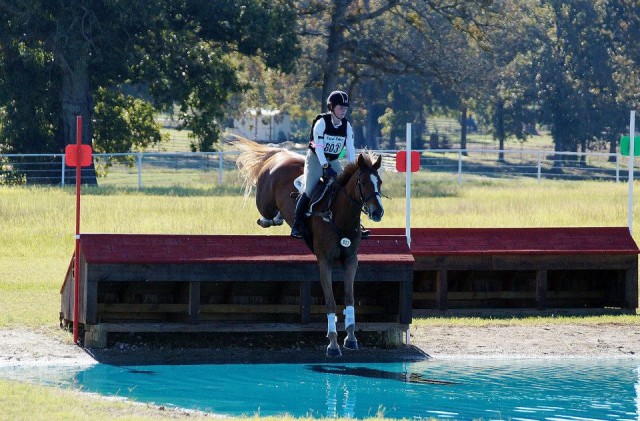 Kim Severson and Fernhill Fearless at the 2014 World Equestrian Games. Photo by Jenni Autry.
Kim Severson and Fernhill Fearless at the 2014 World Equestrian Games. Photo by Jenni Autry.
She won the Rolex Kentucky CCI4* not once, not twice, but THREE times with Winsome Adante in 2002, 2004 and 2005. She was also part of the gold medal winning USA team at the 2002 World Equestrian Games in Jerez, Spain, where they placed 6th individually. And to top it all off, she competed at the 2004 Olympics in Athens, where she won the individual silver medal and team bronze. Of course, I’m referring to the one and only Kim Severson!
I would love to know more about Kim’s everyday life, competition schedule and training routine — wouldn’t you?! She’s truly a remarkable rider, coach, competitor and the list goes on. Luckily, Taylor Mohr, a new member at Kim Severson Eventing, agreed to walk us through life at Kim’s, so without further ado …
EN: How old are you and where are you originally from?
Taylor: “I am 22. I was born in Boston, Massachusetts, but have moved around a bunch throughout the years. I guess I would consider myself from Vermont, as that’s where I lived the longest at an age where I remember it!”
EN: How long have you been riding and eventing?
Taylor: “I was first put on a horse at 3 by a family friend and never looked back! I started taking formal lessons at 5 1/2 and switched to riding at an event barn at age 11. I’ve worked with a variety of trainers and have spent the last two years focusing strictly on dressage while working on a degree in psychology.”
EN: What drew you to Kim Severson’s Barn, and how long have you been working for her?
Taylor: “When I made the decision to consider taking a year off from school to ride and compete, I told myself that I wouldn’t actually take the year if I didn’t find the ‘perfect’ situation. I had no interest in being at a huge upper level barn with eight working students and 40 horses. I wanted to be with a trainer I respected and could learn a lot from but in a bit of a lower key situation. But I also wanted to be with someone that was actively riding at the upper levels as well.
“I came down to interview with Kim and was impressed by the small size of her program, the tranquility of the farm, and the intense organization and attention to detail in every aspect of the facility. I started right after Fair Hill, so I’ve been here almost three months now!”
EN: Did you ever imagine yourself working at Kim’s barn?
Taylor: “Absolutely not! I never even imagined her responding to my email let alone having an interest in having me at her barn, as I had just come back from taking a two-year break from eventing and am not an upper-level rider.”
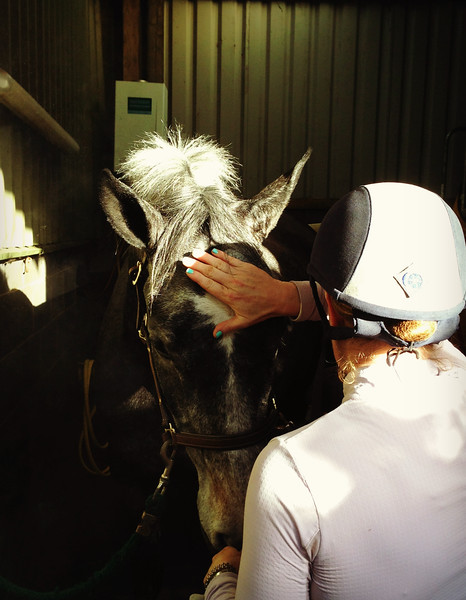
Cooley Quality Control and Kim Severson in Ireland. Photo by Theresa Bujnoch.
EN: How has your experience been so far at Kim’s?
Taylor: “It’s such a learning experience. I learn so much every day, whether it’s on horseback, on the ground or stable management/horse care.”
EN: What does a typical day look like at Kim’s?
Taylor: “We start around 7:30 a.m., feed, change blankets, etc. All of our horses live out 24/7 unless the weather is terrible, so all of Kim’s horses come in each morning to be groomed and checked over. Kim comes out and rides her horses, and Mattie (the head groom/barn manager) and I trot any horses that need to be done and ride/have lessons on our own horses.
“We get all the horses back out to feed lunch and clean up the barn. Some afternoons Kim teaches lessons to truck-ins and other afternoons we have projects like jump painting, moving horses around or re-setting the jump ring. We feed around 5 p.m. and then are done for the night!”
EN: What is it like working for such an accomplished and talented event rider?
Taylor: “It’s a pretty cool experience. The opportunities I’ve had even in the barely three months I’ve been here have been pretty incredible, like going horse shopping in Ireland! And I enjoy the wide variety of horses in the barn that I’ve gotten the chance to sit on!”

Trot Sets! Photo by Taylor Mohr.
EN: What is it like taking a lesson from Kim?
Taylor: “I was told on my first day at KSE by our vet: ‘Kim teaches every student like they are headed for the Olympics no matter what their goals are,’ and that is absolutely true. Her lessons are tough, and she is always completely honest if you keep messing the same thing up. She always checks in to make sure I understand what she’s saying/explaining, which is helpful as well.
“I especially love the lessons where she is on one of her horses while teaching because she demonstrates what I’m doing wrong and then how to do it correctly. I also really appreciate that even when I’m not in a ‘lesson’ but am riding while she’s working with one of her horses or teaching someone else, she will yell out tips to correct my position and more effectively ride whichever horse I’m sitting on.”
EN: What have you learned so far about riding and training?
Taylor: “I think the biggest thing is how much we focus on fitness. Our horses trot and do hill work multiple times a week. And in what seems like mundane trot sets, we still work on forward and back and transitions. We also work with a lot of trot poles and cavaletti as part of out flat work and jump warm up.
“One of Kim’s favorite exercises is to place cavaletti at (seemingly!) random distances down the long side and have us count strides and then focus on adjusting the canter to fit a greater or lesser number of strides in the same distances. I never realized how helpful trot poles are with helping horses figure out where their feet are, especially the babies!”
EN: Are you able to watch Kim ride, and what have you gained from such an experience?
Taylor: “I watch Kim ride quite a bit, whether that’s riding alongside her or setting fences for a jump school. She always has a conversation with her horses, whether actually out loud or not. But she’s very verbally rewarding to all her horses when they are working on tough stuff and get it right, and I have yet to see her even get remotely upset with the horses.”
EN: You recently went to Ireland. Tell us about that experience and what you brought back to the States?
Taylor: “Ireland was one of the most beautiful and wonderful places I’ve ever been. The situation surrounding my trip was completely unexpected, and I decided I was going about a week before we left. So I didn’t have much time to prepare, but it was totally worth it and was difficult to force myself to come home.
“It’s really awesome to be able to sit on such a variety of young horses in a tight time period; I jumped fences I wouldn’t have considered jumping in the U.S. and on 4- and 5-year-olds I had never ridden before. I ended up bring home a 5-year-old Irish Sport Horse gelding, Cooley High Water, who I’m having a lot of fun with. He’s super green but will jump anything I put in front of him. Now having been over there, I completely understand why the Irish horses are so game on cross country”

Cooley High Water. Photo by Taylor Mohr.
EN: What are your short term and long-term goals as a rider?
Taylor: “My goals for right now are to get my new Irish horse going and out in the event world. He’s entered at some events in Aiken, and I’m really looking forward to the process of moving him up through the levels. He has a super brain and is very willing, so I’m excited to see what he can do.
“I can’t think of a better place to be with a young horse than with Kim, and I’m happy to have her guidance through the process. Longer term, I would love to do a one-star, but at this point we have to work on staying in the dressage ring and on a 20-meter circle. So that’s a bit of a ways off. “
EN: Other than the obvious reasons for working for someone with such tremendous accomplishments, why would you point a young ambitious rider towards Kim’s?
Taylor: “Kim is super down to earth and very honest. She will tell you how she feels, and that’s a character trait I really respect in an individual. She offers advice on a ‘take it or leave it’ basis, and even if I initially may seem hesitant about something she’s suggesting, she pretty much always ends up being right. I also love that she’s brought so many young and green horses all the way to the upper levels of the sport.”
EN: What are you most looking forward to next?
Taylor: “We leave for Aiken in less than two weeks, which I’m really looking forward to. I’ve never been to Aiken or been able to be south for an entire spring season, so I’m pretty excited about that. We also have a lot of really cool young horses in the barn right now, and it’s going to be a fun spring/summer watching them mature and grow up and enter the event world.”
Thank you so much for chatting with EN, Taylor, and good luck in 2015 to Team KSE!








